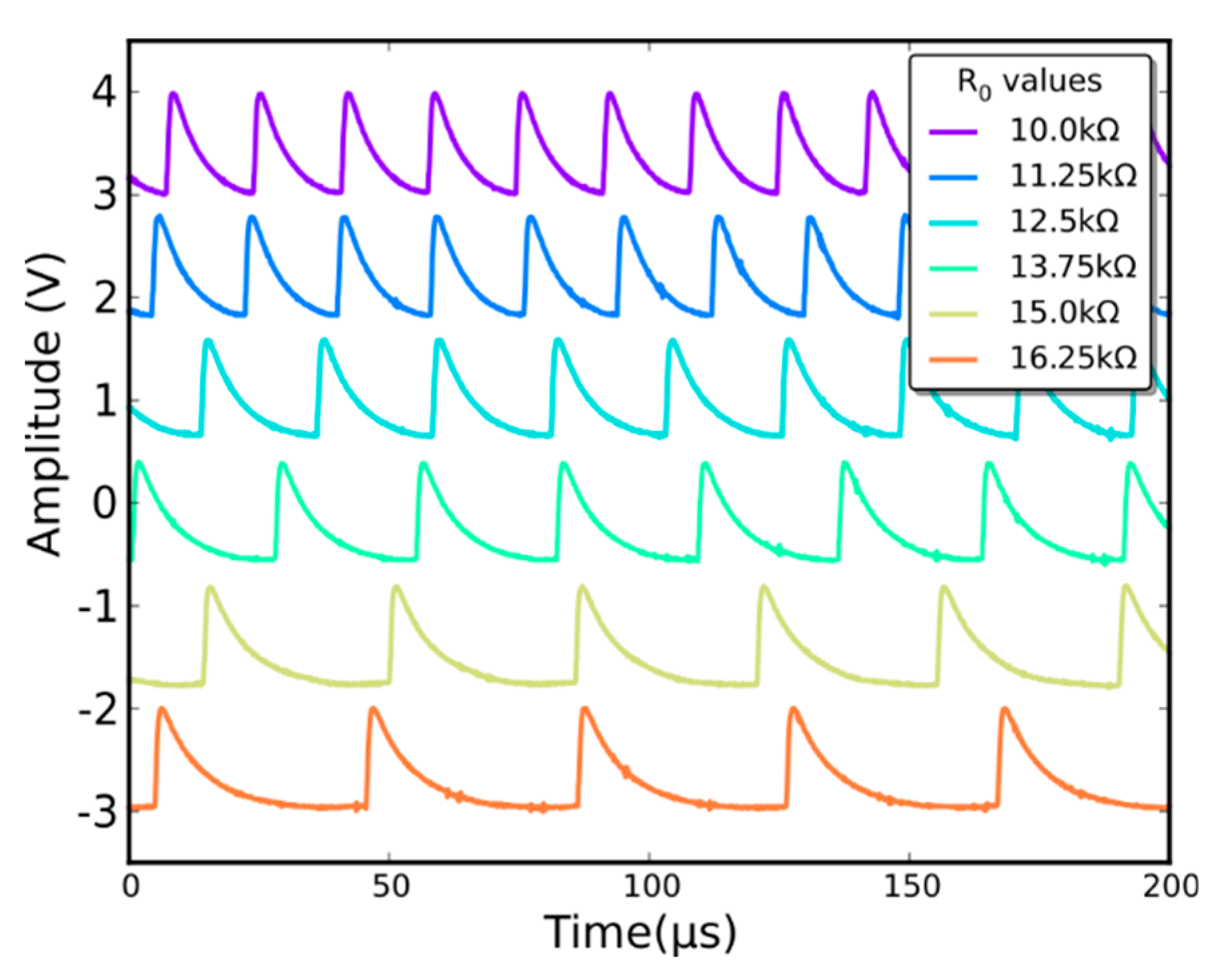VO2: A Phase Change Material for Micromechanics †
Abstract
:1. Introduction
2. Electrical Oscillations in a VO2-Based Microbridge
3. Spontaneous Mechanical Actuation from DC Bias
Acknowledgments
Conflicts of Interest
References
- Park, J.H.; Coy, J.M.; Kasirga, T.S.; Huang, C.; Fei, Z.; Hunter, S.; Cobden, D.H. Measurement of a solid-state triple point at the metal-insulator transition in VO2. Nature 2013, 500, 431–434. [Google Scholar] [CrossRef] [PubMed]
- Brockman, J.S.; Gao, L.; Hughes, B.; Rettner, C.T.; Samant, M.G.; Roche, K. P; Parkin, S.S. P. Subnanosecond incubation times for electric-field-induced metallization of a correlated electron oxide. Nat. Nanotechnol. 2014, 9, 453–458. [Google Scholar] [CrossRef] [PubMed]
- Liu, K.; Cheng, C.; Cheng, Z.; Wang, K.; Ramesh, R.; Wu, J. Giant-Amplitude, High-Work Density Microactuators with Phase Transition Activated Nanolayer Bimorphs. Nano Lett. 2012, 12, 6302–6308. [Google Scholar] [CrossRef] [PubMed]
- Guo, H.; Wang, K.; Deng, Y.; Oh, Y.; Syed Asif, S.A.; Warren, O.L.; Shan, Z.W.; Wu, J.; Minor, A.M. Nanomechanical actuation from phase transitions in individual VO2 micro-beams. Appl. Phys. Lett. 2013, 102, 231909. [Google Scholar] [CrossRef]
- Manca, N.; Pellegrino, L.; Kanki, T.; Venstra, W.J.; Mattoni, G.; Higuchi, Y.; Tanaka, H.; Caviglia, A.D.; Marré, D. Selective High-Frequency Mechanical Actuation Driven by the VO2 Electronic Instability. Adv. Mat. 2017, 29, 1701618. [Google Scholar] [CrossRef] [PubMed]
- Manca, N.; Kanki, T.; Tanaka, H.; Marré, D.; Pellegrino, L. Influence of thermal boundary conditions on the current-driven resistive transition in VO2 microbridges. Appl. Phys. Lett. 2015, 107, 143509. [Google Scholar] [CrossRef]
- Taketa, Y.; Kato, F.; Nitta, M.; Haradome, M. New oscillation phenomena in VO2 crystals. Appl. Phys. Lett. 1975, 27, 212–214. [Google Scholar] [CrossRef]



Publisher’s Note: MDPI stays neutral with regard to jurisdictional claims in published maps and institutional affiliations. |
© 2017 by the authors. Licensee MDPI, Basel, Switzerland. This article is an open access article distributed under the terms and conditions of the Creative Commons Attribution (CC BY) license (https://creativecommons.org/licenses/by/4.0/).
Share and Cite
Manca, N.; Pellegrino, L.; Kanki, T.; Venstra, W.J.; Mattoni, G.; Higuchi, Y.; Tanaka, H.; Caviglia, A.D.; Marré, D. VO2: A Phase Change Material for Micromechanics. Proceedings 2017, 1, 294. https://doi.org/10.3390/proceedings1040294
Manca N, Pellegrino L, Kanki T, Venstra WJ, Mattoni G, Higuchi Y, Tanaka H, Caviglia AD, Marré D. VO2: A Phase Change Material for Micromechanics. Proceedings. 2017; 1(4):294. https://doi.org/10.3390/proceedings1040294
Chicago/Turabian StyleManca, Nicola, Luca Pellegrino, Teruo Kanki, Warner J. Venstra, Giordano Mattoni, Yoshiyuki Higuchi, Hidekazu Tanaka, Andrea D. Caviglia, and Daniele Marré. 2017. "VO2: A Phase Change Material for Micromechanics" Proceedings 1, no. 4: 294. https://doi.org/10.3390/proceedings1040294




